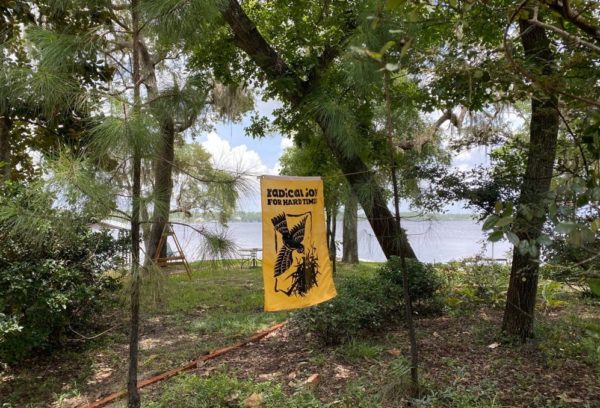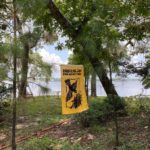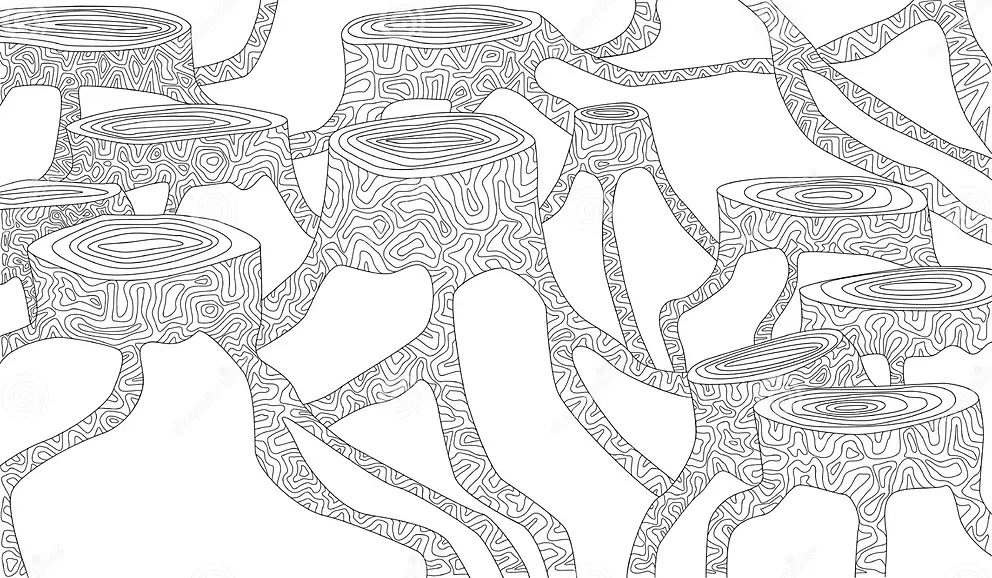Story Info
Story Info

Mike Beck
Navarre, FL
2020
Type of Wounded Place
Story & Experience
What constitutes a “worthwhile action” when the whole of Earth is sick and wounded, when people are so without a sense of place they are willing to set what passes for theirs on fire?
So, this year I chose to sit alone with this question below an old Radical Joy banner hanging from a rope tied to two scrawny longleaf pines where I live. After ten plus years of participating in Earth Exchanges and similar ceremonies at dozens of places in the natural world across the breath of this country I was feeling done with the dark side of nature with all her hurricanes, landslides and pandemics, as well as man-made messes like clearcut forests and oil spills. Sitting in the dappled sunlight and just “being” felt a better action than “doing” anything. Besides, my property technically qualifies as wounded. I’ve survived five direct hit hurricanes in the 27 years that I’ve lived in northwest Florida.
Gary Snyder, an American poet, lecturer, environmentalist has famously written, “If you don’t know where you are you don’t know who you are.” He calls himself a “placed person.” When I found this remote and heavily forested land to retire to after a long career in the Air Force, I would have easily classified myself as “unplaced” if I had been into reading the likes of Gary Snyder back then. But I wasn’t. I had lived my life hasty, shallow and restless. I was acquainted with many places, rooted in none. Some towns I lived in I barely remember the names of. I drug my exposed roots around behind, me. No place had a chance to be more than just the backdrop against which the dramas of my life unfolded. I lacked a stomping ground, some place that felt like a comfortable sweater or an old jeans jacket that I looked forward to returning to. I envied people who had lived in one place their whole life in the same house and had attics that proved it.
I can honestly say it took the combination of going to wounded places and opening myself to the storied land I live on to become a placed person. It was a slow process involving all the senses, memory, membership in tribe—familial or social—and openness to mystery. It came for me by slow accrual such as watching the patterns of place like how the winds blows long before a frontal passage comes with a storm or just rain. Developing a sense of place one year showed itself happening when I looked up from my porch and “knew” the trees of autumn were about to leaf. At other times it grew out of study, such as when I became interested in why the subdivision I lived in was called Hiawatha. That led to finding out about who was first on these lands. It was the Creek, the Choctaw and Miccosukee as it turns out. It wasn’t always slow nor always local. Some things occurred relatively quickly, like the time I came home after attending a clearcut forest in the Pacific Northwest and telling anyone that would listen about going from repulsed to amazed in four quick days by watching beauty and life struggling up through the slash towards the light. I remember writing Trebbe after that experience and complaining about the assumption they were places we were compelled to avert our eyes. I was excited because I had been “wooed by the un-beautiful.” Ever since wounded places for me are un-beautiful, not ugly.
I couldn’t help but spend some time today thanking those spindly longleaf pines that I had rescued from a dumpster for being my teachers also. I’ve learned a lot about them since not knowing the difference between a longleaf pine and sawgrass. Their species were once the dominant plant of the south, covering 90 million acres from Virginia to east Texas. They provided timber to build colonial America, along with tar, pitch and turpentine to construct and maintain great wooden sailing vessels like the early Spanish explorers of the 16th century use to haul theirs into the shallow waters of the bay near my house for repairs. If you look closely at the picture you’ll see those two mutt trees are far from fully mature, from being good wood. When they are they will be a 100 feet or more tall and have grown down a tap root 8 to 12 feet long.
They are unlikely to play a noticeable role in bringing back dominance of their kind in the south, but I did salvage them because we have lost all but 5% of those great forests. And for sure I won’t be around to see their crowning glory. That’s okay with me. I’m grateful for the role they’ve played in helping me sink my tap root down into a sense of place that is good for all seasons and the rest of my days.
What constitutes a “worthwhile action” when the whole of Earth is sick and wounded, when people are so without a sense of place they are willing to set what passes for theirs on fire?
So, this year I chose to sit alone with this question below an old Radical Joy banner hanging from a rope tied to two scrawny longleaf pines where I live. After ten plus years of participating in Earth Exchanges and similar ceremonies at dozens of places in the natural world across the breath of this country I was feeling done with the dark side of nature with all her hurricanes, landslides and pandemics, as well as man-made messes like clearcut forests and oil spills. Sitting in the dappled sunlight and just “being” felt a better action than “doing” anything. Besides, my property technically qualifies as wounded. I’ve survived five direct hit hurricanes in the 27 years that I’ve lived in northwest Florida.
Gary Snyder, an American poet, lecturer, environmentalist has famously written, “If you don’t know where you are you don’t know who you are.” He calls himself a “placed person.” When I found this remote and heavily forested land to retire to after a long career in the Air Force, I would have easily classified myself as “unplaced” if I had been into reading the likes of Gary Snyder back then. But I wasn’t. I had lived my life hasty, shallow and restless. I was acquainted with many places, rooted in none. Some towns I lived in I barely remember the names of. I drug my exposed roots around behind, me. No place had a chance to be more than just the backdrop against which the dramas of my life unfolded. I lacked a stomping ground, some place that felt like a comfortable sweater or an old jeans jacket that I looked forward to returning to. I envied people who had lived in one place their whole life in the same house and had attics that proved it.
I can honestly say it took the combination of going to wounded places and opening myself to the storied land I live on to become a placed person. It was a slow process involving all the senses, memory, membership in tribe—familial or social—and openness to mystery. It came for me by slow accrual such as watching the patterns of place like how the winds blows long before a frontal passage comes with a storm or just rain. Developing a sense of place one year showed itself happening when I looked up from my porch and “knew” the trees of autumn were about to leaf. At other times it grew out of study, such as when I became interested in why the subdivision I lived in was called Hiawatha. That led to finding out about who was first on these lands. It was the Creek, the Choctaw and Miccosukee as it turns out. It wasn’t always slow nor always local. Some things occurred relatively quickly, like the time I came home after attending a clearcut forest in the Pacific Northwest and telling anyone that would listen about going from repulsed to amazed in four quick days by watching beauty and life struggling up through the slash towards the light. I remember writing Trebbe after that experience and complaining about the assumption they were places we were compelled to avert our eyes. I was excited because I had been “wooed by the un-beautiful.” Ever since wounded places for me are un-beautiful, not ugly.
I couldn’t help but spend some time today thanking those spindly longleaf pines that I had rescued from a dumpster for being my teachers also. I’ve learned a lot about them since not knowing the difference between a longleaf pine and sawgrass. Their species were once the dominant plant of the south, covering 90 million acres from Virginia to east Texas. They provided timber to build colonial America, along with tar, pitch and turpentine to construct and maintain great wooden sailing vessels like the early Spanish explorers of the 16th century use to haul theirs into the shallow waters of the bay near my house for repairs. If you look closely at the picture you’ll see those two mutt trees are far from fully mature, from being good wood. When they are they will be a 100 feet or more tall and have grown down a tap root 8 to 12 feet long.
They are unlikely to play a noticeable role in bringing back dominance of their kind in the south, but I did salvage them because we have lost all but 5% of those great forests. And for sure I won’t be around to see their crowning glory. That’s okay with me. I’m grateful for the role they’ve played in helping me sink my tap root down into a sense of place that is good for all seasons and the rest of my days.
Navarre, FL
RECENT STORIES
Remembrance Day for Lost Species in Helsinki 2023
On November 30th, there was first a session organized by the Finnish social and health sector project about eco-anxiety and eco-emotions (www.ymparistoahdistus.fi). This “morning coffee roundtable”, a hybrid event, focused this time on ecological grief [...]
Ashdown Forest
Ashdown Forest is an area of natural beauty in West Sussex, England. It is also one of the very few remaining areas of extensive lowland heath left in Europe. This rare and threatened landscape is [...]



